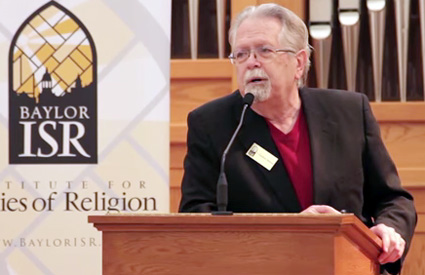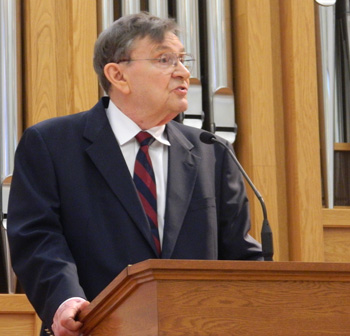By Ken Camp
Reports about the imminent death of religion, the rise of secularization and the growth of atheism largely ignore facts or rely on faulty research, scholars from Baylor University’s Institute for Studies of Religion said during a recent conference.
Reports emphasizing the rise of “nones” and the massive flight of Millennials from organized religion greatly exaggerate — and sometimes misinterpret — hard data, said Byron Johnson, distinguished professor of the social sciences at Baylor and founding director of the Institute for Studies of Religion.
“There’s a story some people want to report — that religion is on life support — but it’s just not true,” he asserted.
Surveys that report Millennials have left the faith of their parents often really mean they have stopped attending church for a few years or identify with a nondenominational church rather than a Mainline denomination — not that they have abandoned Christianity, he said, pointing to findings from the Baylor Religion Survey.
While Mainline Protestant denominations declined 49 percent from 1960 to 2000, other religious groups — including evangelicals — registered dramatic growth, he said. Some researchers and reporters fail to consider the phenomenon of religious “switching” — moving from one Christian group to another, he said.
Johnson sees “switching” as evidence of religious health and vitality, rather than decline.
The Baylor Religion Survey — with more than 350 religion-related questions — explores the nuances and complexities of how people self-identify in terms of faith, he said.
Dispelling the hype
In contrast, some of the hype surrounding the growth of “nones” is based on one question on the American Religious Identification Survey or a misinterpretation of data from the Pew Religious Landscape Survey, Johnson said.
For example, he noted the Baylor study asked follow-up questions of people who indicated “no religion,” and many of those same people identified with specific congregations.
“When they do list a church, it’s often high-octane religion” such as nondenominational evangelical congregations, he added.
The rise of “in-your-face, confrontational” atheism as personified by authors Christopher Hitchens, Sam Harris and Richard Dawkins represents unbelievers’ reaction to atheism’s failure to gain a wide following, said Gordon Melton, distinguished professor of American religious history at Baylor and director of the Institute for the Study of American Religion.
“Religion is alive and well,” he said. “Neo-atheism is a reaction to stagnant atheism.”
Melton provided context for contemporary discussions of atheism by tracing the history of unbelief and skepticism in America.

Three strains of European unorthodoxy — Unitarianism, universalism and deism — found a following in the American colonies, including among some of the founders such as Ben Franklin, Thomas Jefferson and John Adams, he said.
By the mid-19th century, the “freethought” movement gained some measure of popularity, as evidenced by the creation of Robert Owen’s utopian New Harmony community in Indiana and by the founding of freethought settlements by German immigrants, including Comfort and Boerne in South Central Texas.
By 1944, American atheists numbered about 4 million, and atheists created multiple organizations in the post-World War II era. Even so, atheists consistently numbered 4 to 5 percent of the total U.S. population, Melton noted.
“People have been predicting the end of religion for more than three centuries,” said Rodney Stark, distinguished professor of social sciences at Baylor and co-director of the Institute for Studies of Religion.
Worldwide, eight in 10 people belong to one of the major organized faiths, and about three-fourths say religion has an impact on their daily lives, he said.
World probably ‘more religious than a century ago’
“The world probably is much more religious than a century ago,” he said, pointing to data from the Gallup World Poll of 163 nations.
For centuries, when Latin America was considered a monolithically Roman Catholic continent, no more than 20 percent of the people — usually closer to 10 percent — attended Mass, Stark said.
However, the growth of evangelical Protestantism there in the latter half of the 20th century sparked a charismatic renewal movement within Roman Catholicism. Today, he said, more than 60 percent of the people in Latin America attend Mass weekly, in addition to those who attend various Protestant traditions.
“What wasn’t a Catholic continent in fact is now very much a Christian continent,” Stark said.

Sub-Saharan Africa is home to 10,000 independent, indigenous Christian movements, and in some areas there, 80 to 90 percent of the people attend weekly worship services, he said.
Based on a 2007 survey, researchers estimate about 73 million Christians in China, compared to 10 million in 1980, he said.
In Europe, often cited as “the poster child for secularization,” religion continues to thrive in some places, such as Poland and Slovakia, said Philip Jenkins, distinguished professor of history at Baylor.
Migrants bring religious vitality
“Migrant religion” brings vibrancy to religious life in some places where secularization has advanced, such as Great Britain, he noted.
“The four largest megachurches in Great Britain — and yes, there are megachurches there — are pastored by black Africans,” he said.
Jenkins also noted in Scandinavia, the year continues to be structured around religious holidays, and throughout Europe, religious shrines attract record numbers of visitors on pilgrimages.
“There is this spiritual element even in the oddest places,” he observed.
Culturally, Jenkins asserted the most significant films with serious religious themes have been produced in Europe. He cited Michael Sheen’s The Gospel of Us, along with the Russian film The Islandand Finland’s Letters to Father Jacob as prime examples.
